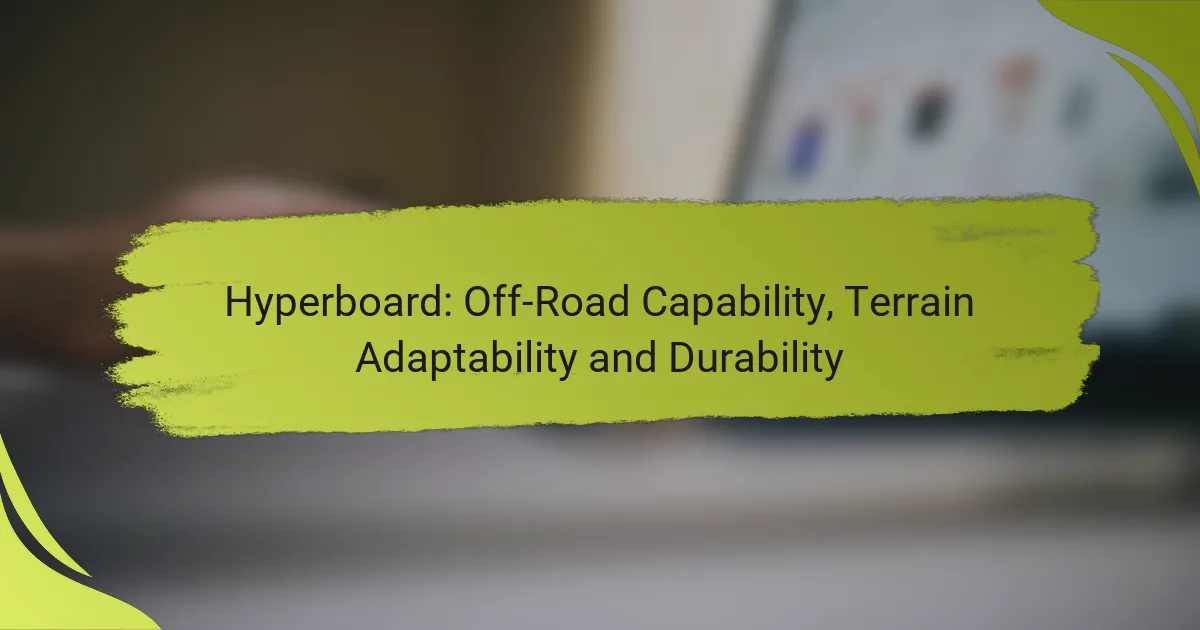The Hyperboard is engineered for outstanding off-road performance, effortlessly tackling diverse terrains with its advanced features. With all-terrain traction, high ground clearance, and a robust suspension system, it excels in adaptability and durability, making it ideal for challenging environments. Its customizable ride height and terrain-specific modes further optimize performance, while high-strength materials ensure longevity against harsh conditions.

What are the off-road capabilities of Hyperboard?
The Hyperboard is designed for exceptional off-road capabilities, enabling it to navigate various terrains with ease. Its features, including all-terrain traction, high ground clearance, and a robust suspension system, contribute to its adaptability and durability in challenging environments.
All-terrain traction
The Hyperboard’s all-terrain traction system ensures optimal grip on diverse surfaces, such as mud, sand, and gravel. This is achieved through specialized tires that provide enhanced surface contact and stability, allowing riders to tackle steep inclines and uneven ground confidently.
When selecting a Hyperboard for off-road use, consider the tire tread pattern and material, as these factors significantly affect traction. A deeper tread can improve grip in softer terrains, while a flatter design may excel on harder surfaces.
High ground clearance
High ground clearance is a critical feature of the Hyperboard, allowing it to traverse obstacles like rocks and tree roots without getting stuck or damaged. Typically, a ground clearance of at least 10 cm is recommended for effective off-road performance.
Riders should be aware that while higher ground clearance enhances off-road capability, it may affect stability at high speeds. Balancing clearance with a low center of gravity is essential for maintaining control during rides.
Robust suspension system
The Hyperboard is equipped with a robust suspension system designed to absorb shocks and bumps, providing a smoother ride over rough terrain. This system typically includes adjustable shocks that can be tuned based on the rider’s weight and the terrain type.
When using the Hyperboard on rugged trails, ensure that the suspension settings are appropriate for the conditions. A stiffer suspension may be beneficial for smoother paths, while a softer setup can enhance comfort on bumpy surfaces.

How does Hyperboard adapt to different terrains?
Hyperboard adapts to various terrains through a combination of adjustable ride height, terrain-specific modes, and customizable tire options. These features enhance its off-road capability and ensure optimal performance on different surfaces.
Adjustable ride height
The adjustable ride height feature allows users to modify the board’s clearance based on the terrain. This flexibility is crucial for navigating obstacles like rocks or deep ruts, providing better ground clearance when needed.
Typically, the ride height can be adjusted within a range of several centimeters, allowing for quick adaptations to changing conditions. Users should consider the trade-off between stability at lower heights and maneuverability at higher settings.
Terrain-specific modes
Terrain-specific modes optimize the Hyperboard’s performance for different environments, such as mud, sand, or rocky paths. Each mode adjusts the board’s power distribution, traction control, and suspension settings to match the terrain’s demands.
For example, the mud mode may enhance grip and reduce power to prevent wheel spin, while the sand mode could allow for more power to help glide over soft surfaces. Familiarizing oneself with these modes can significantly improve the riding experience.
Customizable tire options
Customizable tire options are essential for maximizing the Hyperboard’s adaptability. Users can select tires designed for specific terrains, such as knobby tires for off-road traction or smoother tires for paved surfaces.
Choosing the right tires can impact handling, comfort, and durability. It’s advisable to consider the typical riding conditions and select tires that balance performance with longevity, ensuring the best experience across various terrains.

What makes Hyperboard durable?
Hyperboard’s durability stems from its robust construction, designed to withstand harsh off-road conditions. Key factors include the use of high-strength materials, weather-resistant components, and an impact-resistant design that collectively enhance its longevity and reliability.
High-strength materials
The Hyperboard is built using advanced composite materials that provide exceptional strength-to-weight ratios. These materials are engineered to resist bending and breaking under stress, making them ideal for rugged terrains.
For instance, the frame often incorporates aluminum alloys or carbon fiber, which are known for their lightweight yet sturdy properties. This combination allows the Hyperboard to maintain agility while ensuring it can handle rough surfaces without compromising structural integrity.
Weather-resistant components
To ensure performance in various weather conditions, Hyperboard utilizes weather-resistant components that prevent damage from moisture, UV rays, and extreme temperatures. Sealed electronics and corrosion-resistant finishes are standard features that enhance its usability in wet or sunny environments.
This weatherproofing means that users can confidently ride in rain or shine without worrying about equipment failure. Regular maintenance, such as checking seals and cleaning components, can further extend the lifespan of these weather-resistant features.
Impact-resistant design
The impact-resistant design of the Hyperboard includes reinforced areas that absorb shocks from rough landings or bumps. This design minimizes the risk of damage during high-impact activities, such as jumping or navigating rocky paths.
Key elements like shock-absorbing suspension systems and strategically placed bumpers help distribute force evenly, reducing wear and tear. Riders should inspect these areas regularly for signs of stress or damage to maintain optimal performance.

What are the key features of Hyperboard for UK users?
The Hyperboard offers UK users exceptional off-road capability, terrain adaptability, and durability, making it ideal for diverse outdoor conditions. Its design focuses on stability, lightweight materials, and robust construction to enhance performance across various terrains.
Enhanced stability on wet surfaces
The Hyperboard is engineered to provide enhanced stability on wet surfaces, which is crucial for safe navigation in rainy UK weather. Its specialized grip technology ensures that riders maintain control, reducing the risk of slipping or losing balance.
When riding on wet terrain, the board’s low center of gravity and wide stance contribute to improved stability. Users should consider adjusting their riding style to maintain traction, especially on slick or muddy paths.
Lightweight construction for easy handling
The Hyperboard’s lightweight construction facilitates easy handling, making it suitable for both experienced riders and beginners. Weighing significantly less than traditional off-road boards, it allows for effortless maneuverability and transport.
This lightweight design does not compromise durability; the materials used are both strong and resilient. Riders should ensure they are familiar with the board’s balance and handling characteristics to maximize their off-road experience.

What should you consider when choosing an off-road board?
When selecting an off-road board, prioritize its weight capacity, battery life, and warranty support. These factors significantly impact performance, usability, and long-term satisfaction.
Weight capacity
The weight capacity of an off-road board determines how much load it can safely carry, including the rider and any additional gear. Most boards typically support riders weighing between 70 kg to 120 kg, but it’s essential to check the specifications for each model.
Exceeding the weight limit can affect the board’s performance and safety, leading to potential damage. Always consider your weight and any extra equipment you plan to carry when choosing a board.
Battery life
Battery life is crucial for off-road boards, as it dictates how far you can travel on a single charge. Many models offer a range of approximately 15 km to 40 km, depending on terrain and riding style.
Look for boards with removable batteries for easier charging and potential upgrades. It’s wise to consider your typical riding distance and choose a board that comfortably exceeds that range to avoid running out of power during your adventures.
Warranty and support
A solid warranty and reliable customer support are vital when investing in an off-road board. Most manufacturers offer warranties ranging from one to three years, covering defects and certain types of damage.
Before purchasing, review the warranty terms and the availability of customer support. Good support can make a significant difference in resolving issues quickly and ensuring your board remains in optimal condition.
